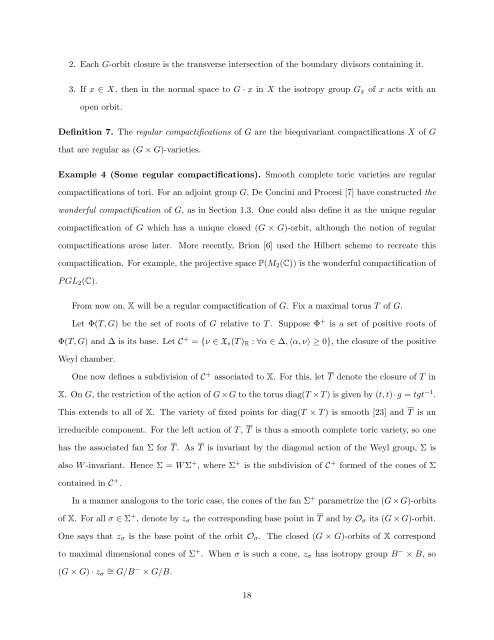Equivariant Embeddings of Algebraic Groups
Equivariant Embeddings of Algebraic Groups
Equivariant Embeddings of Algebraic Groups
You also want an ePaper? Increase the reach of your titles
YUMPU automatically turns print PDFs into web optimized ePapers that Google loves.
2. Each G-orbit closure is the transverse intersection <strong>of</strong> the boundary divisors containing it.<br />
3. If x ∈ X, then in the normal space to G · x in X the isotropy group G x <strong>of</strong> x acts with an<br />
open orbit.<br />
Definition 7. The regular compactifications <strong>of</strong> G are the biequivariant compactifications X <strong>of</strong> G<br />
that are regular as (G × G)-varieties.<br />
Example 4 (Some regular compactifications). Smooth complete toric varieties are regular<br />
compactifications <strong>of</strong> tori. For an adjoint group G, De Concini and Procesi [7] have constructed the<br />
wonderful compactification <strong>of</strong> G, as in Section 1.3. One could also define it as the unique regular<br />
compactification <strong>of</strong> G which has a unique closed (G × G)-orbit, although the notion <strong>of</strong> regular<br />
compactifications arose later. More recently, Brion [6] used the Hilbert scheme to recreate this<br />
compactification. For example, the projective space P(M 2 (C)) is the wonderful compactification <strong>of</strong><br />
P GL 2 (C).<br />
From now on, X will be a regular compactification <strong>of</strong> G. Fix a maximal torus T <strong>of</strong> G.<br />
Let Φ(T, G) be the set <strong>of</strong> roots <strong>of</strong> G relative to T . Suppose Φ + is a set <strong>of</strong> positive roots <strong>of</strong><br />
Φ(T, G) and ∆ is its base. Let C + = {ν ∈ X ∗ (T ) R : ∀α ∈ ∆, 〈α, ν〉 ≥ 0}, the closure <strong>of</strong> the positive<br />
Weyl chamber.<br />
One now defines a subdivision <strong>of</strong> C + associated to X. For this, let T denote the closure <strong>of</strong> T in<br />
X. On G, the restriction <strong>of</strong> the action <strong>of</strong> G×G to the torus diag(T ×T ) is given by (t, t)·g = tgt −1 .<br />
This extends to all <strong>of</strong> X. The variety <strong>of</strong> fixed points for diag(T × T ) is smooth [23] and T is an<br />
irreducible component. For the left action <strong>of</strong> T , T is thus a smooth complete toric variety, so one<br />
has the associated fan Σ for T . As T is invariant by the diagonal action <strong>of</strong> the Weyl group, Σ is<br />
also W -invariant. Hence Σ = W Σ + , where Σ + is the subdivision <strong>of</strong> C + formed <strong>of</strong> the cones <strong>of</strong> Σ<br />
contained in C + .<br />
In a manner analogous to the toric case, the cones <strong>of</strong> the fan Σ + parametrize the (G × G)-orbits<br />
<strong>of</strong> X. For all σ ∈ Σ + , denote by z σ the corresponding base point in T and by O σ its (G × G)-orbit.<br />
One says that z σ is the base point <strong>of</strong> the orbit O σ . The closed (G × G)-orbits <strong>of</strong> X correspond<br />
to maximal dimensional cones <strong>of</strong> Σ + . When σ is such a cone, z σ has isotropy group B − × B, so<br />
(G × G) · z σ<br />
∼ = G/B − × G/B.<br />
18
















